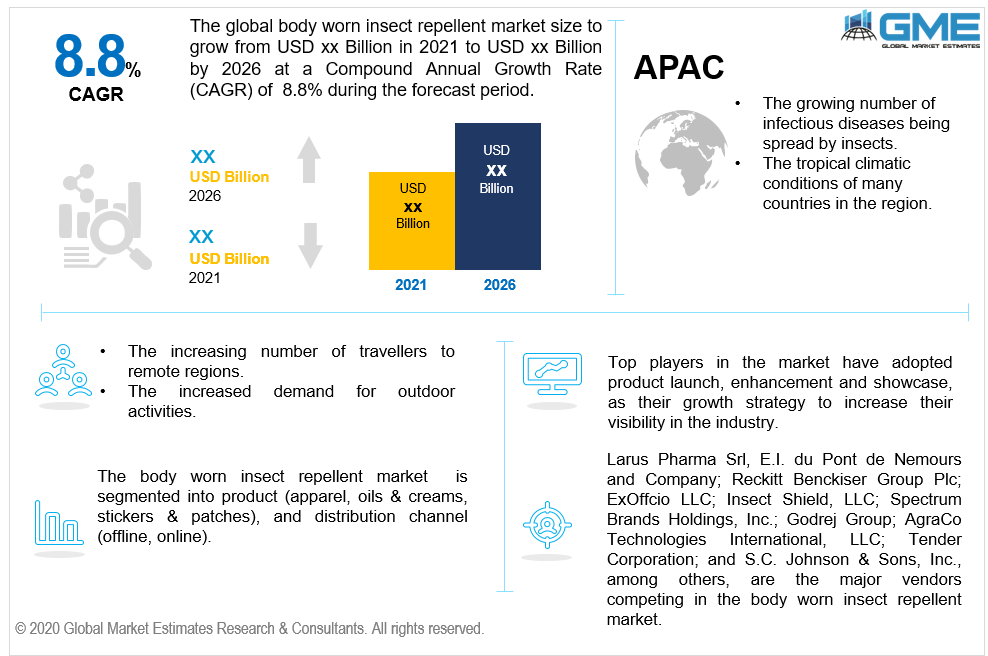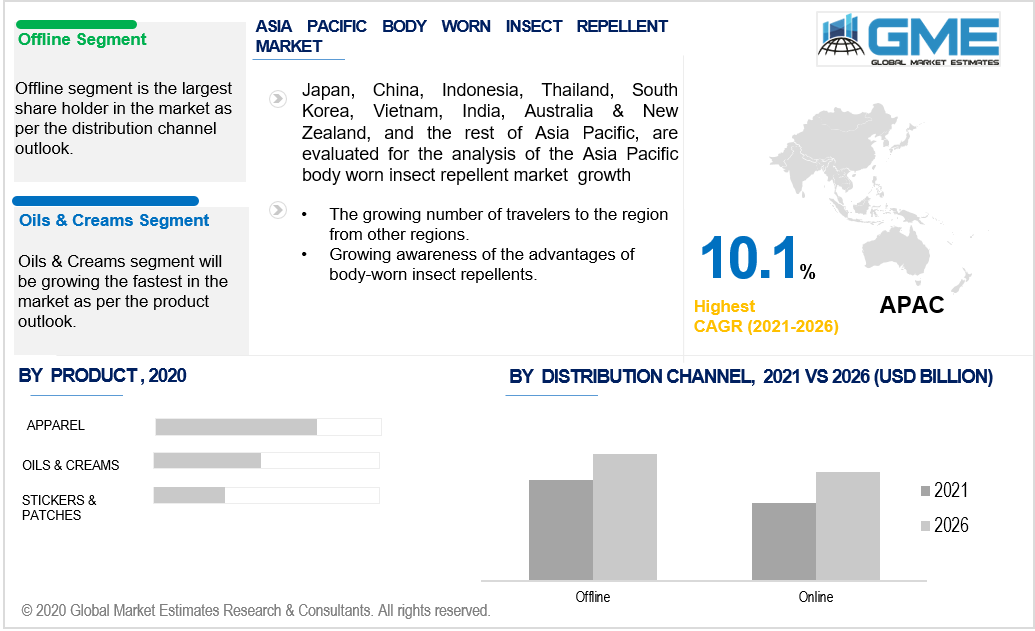
Global Body Worn Insect Repellent Market Size, Trends, and Analysis - Forecasts To 2026 By Product (Apparel, Oils & Creams, Stickers & Patches), By Distribution Channel (Online, Offline), By Region (North America, Asia Pacific, CSA, Europe, and the Middle East and Africa); End-User Landscape, Company Market Share Analysis & Competitor Analysis
Oils, creams, pads, clothing, and stickers that may be sprayed or worn on the body to repel insects are often referred to as body-worn insect repellents. Insect and bug bites also emit toxins into the body that can cause pain, inflammation, and propagate diseases. As per the World Health Organization, vector-borne diseases are responsible for 17% of all infectious diseases. Malaria is a parasitic infectious disease spread by mosquitoes. Malaria has been estimated to cause 219 million cases worldwide leading to an estimated 4,00,000 deaths annually, many of whom are children. Dengue fever is a mosquito-borne infectious disease. Dengue cases are estimated to be around 96 million and cause over 40,000 deaths annually. Across 129 counties, over 3 billion people are at risk of contracting dengue. Other diseases that can be spread by insects are chikungunya, zika virus, yellow fever, West Nile fever, Japanese encephalitis, tick-borne encephalitis, Chagas, leishmaniasis, and schistosomiasis. These diseases are preventable through protective measures. Body-worn insect repellents are an excellent form of protection against contracting such vector-borne diseases.
Body-worn insect repellents inhibit the insect's ability to identify sweat and breath essentially disorienting the insect and thereby preventing them from biting. Insect repellents, vaporizers, and incenses have also been used in the past to prevent the transmission of infectious infections by insects. In recent years, there has been a growing concern about the harmful effects of such methods on the respiratory system.
This growing concern is expected to increase the demand for body-worn insect repellents in the market. The effects of the vaporizers and sprays on the respiratory system are exaggerated in the case of the elderly and infants who have lower immunity and weaker protection. In terms of infectious illnesses, infants and the aged are the most vulnerable groups. The demand for body-worn insect repellents is expected to grow as a result of this issue, especially among the elderly and infant’s populace. Body-worn insect repellents are ideal for infants and the elderly as they are applied to the surface of the skin and do not enter the body.
Additionally, insect repellent companies are increasingly using organic ingredients and ingestion safe ingredients to further enhance their products. Consumers are also increasingly preferring such natural or organic ingredients-based body-worn sect repellents. In recent years, there has been a growing demand for outdoor activities like hiking among the population. As these activities occur outside buildings, there is an added risk of contracting infectious diseases from insects and an increased chance of insect bites. The demand for body-worn insect repellents is expected to grow as a result of the growth in outdoor activities. Traveling for leisure and work has also increased in recent years. People also travel to remote areas for recreation to get away from their daily lives. Such remote areas are often infested with insects thereby increasing the risk of insect bites and contracting infectious diseases. Travelers are often advised to carry body-worn insect repellents with them. The growing number of travelers is also expected to increase the demand for body-worn insect repellents. Body-worn insect repellents like oils and creams are susceptible to ingestion for contact with eyes and mouth which can cause mild side effects like skin irritation, eye irritation, and rashes.
COVID-19 pandemic has restricted travel and also confined people to their homes which have decreased the demand for body-worn insect repellents. COVID-19 has also had an impact on the supply side with supply chains being disrupted and production being shut down due to a lack of availability of raw materials.

Based on the various products, the body-worn insect repellent market can be segmented into oils and creams, stickers and patches, and apparel. The apparel segment is expected to hold the dominant share of the market during the forecast period. All of the active ingredients that resist insect bites are infused into body-worn insect-repellent apparel. The apparel segment is driven by the growing demand from travelers and people participating in outdoor activities like trekking, hiking, and sports where oils and creams might not be suitable. The oils and creams segment is expected to register the fastest growth rate during the forecast period. The oils and creams segment is driven by the product’s long-lasting nature and the increasing number of oils and creams that are made from organic sources.
Based on the distribution channel of body-worn insect repellent, the body-worn insect repellent market can be segmented into offline and online segments. The offline segment is expected to hold the dominant share of the market during the forecast period. Body-worn insect repellents are extensively available in supermarkets, groceries, and pharmacies across the world. As customers prefer to buy body-worn insect repellents during their shopping trip for other necessities, the offline segment is expected to hold its dominant position during the forecast period. The inability of e-commerce stores to serve customers in remote areas or time restraints decreases the demand for the online segments as remote areas are often in dire need of such body-worn insect repellents.

The North American region is expected to largest share of the market during the forecast period. The region has varying climatic conditions that are suitable for the growth of insects which has resulted in the large demand for insect repellents in the region. The region also spends more heavily on healthcare and people are generally more aware of the dangers of vector-borne infectious diseases. The region also has a large number of people traveling to other regions which has also resulted in the large demand for body-worn insect repellents in the region. The APAC region is expected to register the fastest growth rate among all regions. The APAC region has many countries with tropical climates which are highly favorable for insects such as mosquitoes. The region also has poor healthcare and other infrastructure which increases the risk of the spread of infectious diseases through insects. The increasing awareness of the benefits of body-worn insect repellents among consumers in the region is expected to fuel the demand for body-worn insect repellents in the region.
Larus Pharma Srl, ExOffcio LLC, Spectrum Brands Holdings, Inc., AgraCo Technologies International, LLC, S.C. Johnson & Sons, Inc., Reckitt Benckiser Group Plc, Insect Shield LLC, Godrej Group, Tender Corporation, and E.I. du Pont de Nemours and Company, among others, are the major vendors competing in the body-worn insect repellent market.
Please note: This is not an exhaustive list of companies profiled in the report.
We value your investment and offer free customization with every report to fulfil your exact research needs.
The Global Body Worn Insect Repellent Market has been studied from the year 2019 till 2026. However, the CAGR provided in the report is from the year 2021 to 2026. The research methodology involved three stages: Desk research, Primary research, and Analysis & Output from the entire research process.

The desk research involved a robust background study which meant referring to paid and unpaid databases to understand the market dynamics; mapping contracts from press releases; identifying the key players in the market, studying their product portfolio, competition level, annual reports/SEC filings & investor presentations; and learning the demand and supply-side analysis for the Body Worn Insect Repellent Market.

The primary research activity included telephonic conversations with more than 50 tier 1 industry consultants, distributors, and end-use product manufacturers.

Finally, based on the above thorough research process, an in-depth analysis was carried out considering the following aspects: market attractiveness, current & future market trends, market share analysis, SWOT analysis of the company and customer analytics.

Tailor made solutions just for you
80% of our clients seek made-to-order reports. How do you want us to tailor yours?
OUR CLIENTS